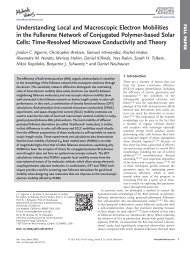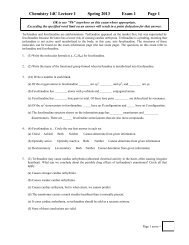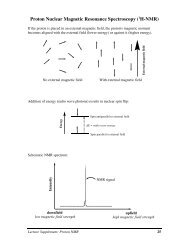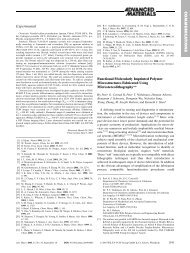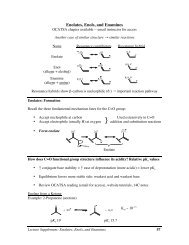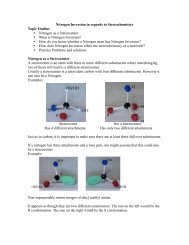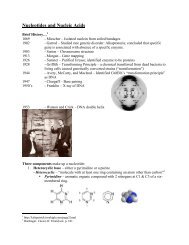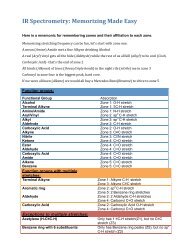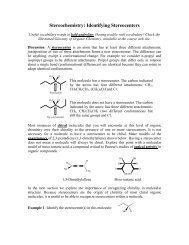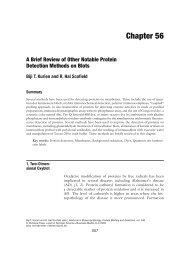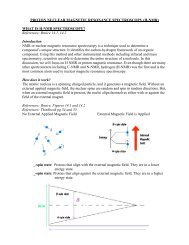Quality Control Procedures of the Chlamydomonas Center Culture ...
Quality Control Procedures of the Chlamydomonas Center Culture ...
Quality Control Procedures of the Chlamydomonas Center Culture ...
You also want an ePaper? Increase the reach of your titles
YUMPU automatically turns print PDFs into web optimized ePapers that Google loves.
<strong>Quality</strong> <strong>Control</strong> <strong>Procedures</strong> <strong>of</strong> <strong>the</strong> <strong>Chlamydomonas</strong> <strong>Center</strong><br />
<strong>Culture</strong> Media<br />
Nearly everything is kept on Sueoka's high salt medium with added acetate and yeast<br />
extract (we call this YA medium). The reasons for this are a) all <strong>the</strong> strains will grow on it,<br />
including auxotrophs like arg and nic mutants; b) it's easy and relatively cheap to make; c) it's an<br />
enriched medium, so if you get contamination with fungi or bacteria, it will be apparent<br />
immediately.<br />
This last point is very important. Bacteria can grow along with <strong>the</strong> Chlamy on acetate or<br />
minimal medium without being obvious. Some bacterial contaminants are very hard to get rid<br />
<strong>of</strong>, because <strong>the</strong>y are sticky or rapidly motile, so it is far better to avoid getting <strong>the</strong>m in <strong>the</strong> first<br />
place. Fungi are usually apparent on YA or acetate medium, but can lurk on minimal medium<br />
without showing up to a casual inspection.<br />
The few exceptions are as follows:<br />
The dark and dim strains on YA do better and last longer with twice <strong>the</strong><br />
concentration <strong>of</strong> acetate. They do better on plates than in tubes.<br />
The osm mutants require TAP medium with ei<strong>the</strong>r sucrose or lactose. They do<br />
fine in tubes on this medium.<br />
A very few strains, mostly o<strong>the</strong>r species <strong>of</strong> Chlamy, don't seem to like acetate and<br />
do better on minimal medium. They do OK in tubes, but need to be watched carefully; once <strong>the</strong>y<br />
start to fade, <strong>the</strong>y expire quickly.<br />
Tubes are made with 10 ml <strong>of</strong> agar and slanted when <strong>the</strong>y come out <strong>of</strong> <strong>the</strong> autoclave.<br />
This provides a bigger surface area from which you can remove loopfuls <strong>of</strong> cells for sending or<br />
transfer. Stab cultures are admittedly a little quicker to transfer, but <strong>the</strong>y don't give you nearly as<br />
good a volume <strong>of</strong> available cells to sample from. Also, it's easier to inspect slant cultures to see<br />
whe<strong>the</strong>r <strong>the</strong>y need to be transferred soon.<br />
To make slants, prepare 1 liter <strong>of</strong> medium in an Erlenmeyer flask and autoclave just long<br />
enough to melt <strong>the</strong> agar. With our autoclave, it takes 12 minutes (plus slow exhaust, <strong>of</strong> course).<br />
Although you can melt <strong>the</strong> agar on a hot plate with a stirring bar, it's <strong>the</strong> proverbial watched pot,<br />
and as soon as you turn your back on it for a second, it will boil over. Dispense 10 ml aliquots<br />
into <strong>the</strong> tubes using <strong>the</strong> motorized pipetter. This goes faster if you use a 10 ml pipette with a<br />
broken tip. Cap, autoclave for 20 minutes, <strong>the</strong>n prop up <strong>the</strong> racks to create <strong>the</strong> slants. It takes<br />
some practice to get exactly <strong>the</strong> right angle; what you want is for <strong>the</strong> agar to reach to about an<br />
inch below <strong>the</strong> top <strong>of</strong> <strong>the</strong> tube. Let <strong>the</strong> tubes age for a week or more before using <strong>the</strong>m,<br />
o<strong>the</strong>rwise <strong>the</strong> agar surface will be wet and <strong>the</strong> Chlamy don't seem to like this.
Minivials for shipping contain 1.5 ml agar, and are also slanted. Use <strong>the</strong> big metal rack<br />
for making <strong>the</strong>se. It holds 90 vials. Make <strong>the</strong>se as part <strong>of</strong> a liter from which <strong>the</strong> rest goes into<br />
slants.<br />
YA medium<br />
1) Beijerinck's solution [in <strong>the</strong> kits that we send out, this is called simply "salts solution"]<br />
NH4Cl 100 g<br />
MgSO4 · 7H2O 4.0 g<br />
CaCl2 · 2H2O 2.0 g<br />
water to 1 liter<br />
For <strong>the</strong> sulfur-free salts solution distributed with <strong>the</strong> hydrogen project kit, substitute 3.30 g<br />
MgCl2 · 6H2O for <strong>the</strong> magnesium sulfate.<br />
For N- medium for gametogenesis, omit <strong>the</strong> ammonium chloride<br />
2) Phosphate solution<br />
K2HPO4 (anhydrous) 288.0 g<br />
KH2PO4 144.0 g<br />
water to 1 liter<br />
3) trace elements (see below)<br />
For YA tubes:<br />
5 ml Beijerinck's<br />
5 ml <strong>of</strong> phosphate<br />
1 ml <strong>of</strong> trace elements<br />
1.2 grams sodium acetate (anhydrous); for <strong>the</strong> hydrated salt use 2.0 g<br />
4 grams yeast extract (Difco)<br />
20 grams agar<br />
For plates, use 15 grams agar per liter<br />
Keep <strong>the</strong> stock solutions in <strong>the</strong> refrigerator. I've never had a problem with <strong>the</strong>m getting<br />
contaminated.
Hutner's Trace Elements<br />
[Hutner et al., Proc. Am. Philos. Soc. 94: 152-170 (1950)]<br />
For 1 liter final mix, dissolve each compound in <strong>the</strong> volume <strong>of</strong> water indicated. The EDTA<br />
should be dissolved in boiling water, and <strong>the</strong> FeSO4 should be prepared last to avoid oxidation.<br />
EDTA disodium salt 50 g 250 ml H2O<br />
ZnSO4. 7 H2O 22 g 100 ml<br />
H3BO3 11.4 g 200 ml<br />
MnCl2. 4 H2O 5.06 g 50 ml<br />
CoCl2. 6 H2O 1.61 g 50 ml<br />
CuSO4.5H2O 1.57 g 50 ml<br />
(NH4)6Mo7O24. 4 H2O 1.10 g 50 ml<br />
FeSO4. 7 H20 4.99 g 50 ml<br />
Mix all solutions except EDTA. Bring to boil, <strong>the</strong>n add EDTA solution. The mixture should<br />
turn green. When everything is dissolved, cool to 70 degrees C.<br />
Keeping temperature at 70, add 85 ml hot KOH (20%).<br />
Cool to room temperature and bring to 1 liter final volume.<br />
Usually <strong>the</strong> solution will be clear green initially but will turn dark red or purple over <strong>the</strong> next few<br />
days and leave a rust-brown precipitate. To accelerate <strong>the</strong> “maturation” process, bubble <strong>the</strong><br />
solution with air overnight on <strong>the</strong> benchtop. If no precipitate forms, or <strong>the</strong> solution remains<br />
green, check <strong>the</strong> pH. It should be about 6.7. If it's radically <strong>of</strong>f this, try adding ei<strong>the</strong>r KOH or<br />
HCl to adjust it.<br />
The ritual calls for stoppering <strong>the</strong> flask with a cotton plug (to allow air exchange) and swirling it<br />
once a day for 1 to 2 weeks.<br />
Filter through two layers <strong>of</strong> Whatman #1 filter paper; repeat if necessary until <strong>the</strong> solution is<br />
clear.<br />
The final product will approximate a good Bordeaux in color. However, even a subtle shift in<br />
pH can cause a color change. We had one batch that looked like grape Koolaid but worked fine.<br />
Store refrigerated or frozen in convenient aliquots. This can be made in larger batches - 2 or 3<br />
liters - if you prefer.
Sulfur-free trace elements<br />
For 1 liter final mix, dissolve each compound in <strong>the</strong> volume <strong>of</strong> water indicated. The EDTA<br />
should be dissolved in boiling water.<br />
EDTA disodium salt 50 g 250 ml H2O<br />
ZnCl2 10.0 g 100 ml<br />
H3BO3 11.4 g 200 ml<br />
MnCl2. 4 H2O 5.06 g 50 ml<br />
CoCl2. 6 H2O 1.61 g 50 ml<br />
CuCl2. 2 H2O 1.00 g 50 ml<br />
(NH4)6Mo7O24. 4 H2O 1.10 g 50 ml<br />
FeCl2.4 H2O 3.60 g 50 ml<br />
As for <strong>the</strong> usual trace elements recipe, mix all solutions except EDTA. Bring to boil, <strong>the</strong>n add<br />
EDTA solution. The mixture should turn green. When everything is dissolved, cool to 70<br />
degrees C. Keeping temperature at 70, add 85 ml hot KOH (20%).<br />
Bring <strong>the</strong> final solution to 1 liter total volume.<br />
The color is <strong>the</strong> same as <strong>the</strong> original trace mix.
Preventing Loss <strong>of</strong> <strong>Culture</strong>s<br />
These recommendations are based on <strong>the</strong> combined 80 years <strong>of</strong> <strong>Chlamydomonas</strong> culturing<br />
experience from Drs. Harris, Lefebvre and Silflow.<br />
Maintain two complete sets <strong>of</strong> cultures, preferably in locations sufficiently far apart that a fire or<br />
o<strong>the</strong>r disaster striking one would be unlikely to hit <strong>the</strong> o<strong>the</strong>r. Designate one set as "primary",<br />
and use that as <strong>the</strong> source for <strong>the</strong> cultures you send out.<br />
Install high-temperature cut-<strong>of</strong>f switches that will turn <strong>of</strong>f <strong>the</strong> lights if <strong>the</strong> air conditioning fails.<br />
For each set <strong>of</strong> cultures, keep tubes in order in racks. Make a chart or numbered list, so that if a<br />
space is open in a rack, you know what tube belongs <strong>the</strong>re.<br />
For cultures kept on plates, put a piece <strong>of</strong> foil on <strong>the</strong> shelf and stick on tape or adhesive labels to<br />
indicate what strain belongs on each spot. Again, if <strong>the</strong>re's a blank space on <strong>the</strong> shelf, something<br />
is missing.<br />
The sooner you realize something is missing, <strong>the</strong> more likely it is you will find it.<br />
Inspect <strong>the</strong> cultures on a regular schedule (see next page).<br />
Nobody uses stock center cultures directly except <strong>the</strong> stock center technician. If o<strong>the</strong>r people in<br />
<strong>the</strong> lab need strains, <strong>the</strong>y ask you and you make plates for <strong>the</strong>m. Make sure everybody in <strong>the</strong> lab<br />
knows this rule, and that it is enforced.<br />
A corollary to this is that if someone takes a stock center strain and modifies it, crosses it, or<br />
o<strong>the</strong>rwise alters it, it should never be entered back into <strong>the</strong> collection under <strong>the</strong> same stock<br />
number. 1<br />
Use pre-printed labels. If you have to transfer a culture and no label is made up, write <strong>the</strong> stock<br />
number on <strong>the</strong> patch on <strong>the</strong> tube itself, not just on <strong>the</strong> cap. But put a label on as soon as you can!<br />
Put a circular label on <strong>the</strong> top <strong>of</strong> every tube when you transfer it. Use a color-coding system that<br />
indicates <strong>the</strong> month <strong>of</strong> transfer. Although some <strong>of</strong> <strong>the</strong>se labels will fall <strong>of</strong>f in time, and <strong>the</strong>y are<br />
admittedly a bit messy, we've found <strong>the</strong>y are worth <strong>the</strong> effort. First, <strong>the</strong>y make it easy to spot a<br />
particular tube in a rack. Second, you will get an idea from <strong>the</strong> transfer dates just how well your<br />
cultures are doing, which ones need to be transferred more frequently, and whe<strong>the</strong>r a culture that<br />
looks weak is getting old or just hasn't had time to grow up yet.<br />
1 case history: a Duke student once took strain CC-373 ac-u-c-2-21 mt+, crossed it, selected <strong>the</strong> same mutation in<br />
mating type minus, <strong>the</strong>n called that strain CC-373 mt-. Eventually someone else got this from him. with an<br />
incomplete history, transformed it with a plasmid and tried to cross one <strong>of</strong> her transformants to a wild-type mt-<br />
strain. Since she assumed it was plus as indicated in <strong>the</strong> stock list, she spent some months <strong>of</strong> frustration thinking her<br />
mating reactions weren't working, or it had acquired a new mutation, until somebody suggested she test <strong>the</strong> mating<br />
type. There are several lessons to be learned here.
Transferring <strong>Culture</strong>s<br />
Until you're familiar with <strong>the</strong> collection and know how cultures will behave under your<br />
conditions, I strongly recommend that you inspect every tube and plate in <strong>the</strong> collection once a<br />
week. Once you're sure everything is growing well, and that you aren't having any problems<br />
with contamination, <strong>the</strong>n you can go to a schedule <strong>of</strong> every two weeks, alternating between <strong>the</strong><br />
primary and backup sets <strong>of</strong> cultures.<br />
<strong>Culture</strong>s on plates should be inspected more frequently, since <strong>the</strong>se are more vulnerable<br />
to fungus contamination than those in tubes, and are also likely to be less healthy.<br />
<strong>Culture</strong>s need transfer if <strong>the</strong>y are<br />
changing from bright/dark green to olive drab<br />
getting very pale<br />
starting to bleach out at <strong>the</strong> top <strong>of</strong> <strong>the</strong> agar<br />
drying out (agar shrinking substantially)<br />
Go through <strong>the</strong> tubes one rack at a time. Pull out anything that looks like it needs transfer<br />
and put it in a separate rack. Fill up this rack with 20 tubes to be transferred, leaving two empty<br />
rows into which you put <strong>the</strong> new tubes. Then put on <strong>the</strong> labels for <strong>the</strong> new tubes, and keep <strong>the</strong><br />
old and new tubes paired in this rack until <strong>the</strong> new culture has grown up. I usually allow one<br />
week for this before putting <strong>the</strong> new cultures away. I usually keep <strong>the</strong> old tubes for several more<br />
weeks, just in case.<br />
Label <strong>the</strong> tubes BEFORE you transfer <strong>the</strong> cells. (This seems obvious, but I've had a<br />
couple <strong>of</strong> people working for me who wanted to transfer first and label later. That's dangerous).<br />
At Duke we used work-study students to put labels on tubes but <strong>the</strong> technician always did <strong>the</strong><br />
actual transfers <strong>of</strong> cultures. Check to make sure labels match a) when you put <strong>the</strong> label on a new<br />
tube, b) when you transfer <strong>the</strong> cells from one to <strong>the</strong> o<strong>the</strong>r, and c) when you put <strong>the</strong> new tube back<br />
in <strong>the</strong> rack in place <strong>of</strong> <strong>the</strong> old one.<br />
If a culture needs to be streaked on a plate for rehabilitation, make sure it is clearly<br />
labeled 2 . I recommend keeping a "hospital shelf" dedicated to such cultures, and a list <strong>of</strong> what's<br />
<strong>the</strong>re at any given moment. This keeps <strong>the</strong>m all in one place where <strong>the</strong>y can be inspected daily,<br />
and mitigates against accidental loss.<br />
2 case history: we had an Israeli technician who made 1's that looked like American 7's. When she went on<br />
maternity leave, someone else took over some cultures she had on plates, but didn't read <strong>the</strong> numbers correctly, so a<br />
plate <strong>of</strong> strain CC-919 was put into a tube labeled CC-979.
Cleaning up contaminated cultures<br />
If, despite your best efforts, a strain gets contaminated, here's a suggested triage system:<br />
1) Check <strong>the</strong> o<strong>the</strong>r set <strong>of</strong> cultures; if <strong>the</strong>re's a good one <strong>the</strong>re, use it as a replacement and discard<br />
<strong>the</strong> contaminated one. Make a note <strong>of</strong> this in your files, just in case a problem arises in <strong>the</strong><br />
future.<br />
2) If both cultures are contaminated, proceed to cleanup efforts:<br />
a) bacteria<br />
For cultures heavily contaminated with bacteria, streak <strong>the</strong> culture on <strong>the</strong> most minimal medium<br />
on which <strong>the</strong> strain in question will grow; e.g., if it will grow on minimal, use HS or Trisminimal;<br />
if it requires acetate, use HSA or TAP but omit <strong>the</strong> yeast extract. The idea is to enrich<br />
<strong>the</strong> Chlamy relative to <strong>the</strong> bacterial population before proceeding to <strong>the</strong> next step<br />
If <strong>the</strong> contamination is slight, check under a dissecting scope to see if <strong>the</strong>re are any<br />
uncontaminated areas, and try to recover a clean colony from <strong>the</strong>re.<br />
If <strong>the</strong>re is slight but uniform contamination (Chlamy is still bright green, seems to outnumber <strong>the</strong><br />
bacteria), <strong>the</strong>n streak several plates <strong>of</strong> YA medium with it. Make one line across <strong>the</strong> plate with a<br />
wire loop or toothpick. Then, under a dissecting scope, use ano<strong>the</strong>r sterile toothpick or glass<br />
needle to streak some Chlamy-rich areas perpendicular to this line, in hopes <strong>of</strong> getting a single<br />
colony that's bacteria-free.<br />
Revisit this plate daily, looking for green colonies. Continue to use a glass needle to try to chase<br />
<strong>the</strong> Chlamy away from <strong>the</strong> bacteria. If it's apparent that <strong>the</strong> bacteria are overtaking <strong>the</strong> plate, you<br />
may need to use ano<strong>the</strong>r tactic.<br />
We prefer not to use antibiotics to clean up cultures. It's not an environmentally friendly<br />
practice, and <strong>of</strong>ten it doesn't work very well ei<strong>the</strong>r. However, if <strong>the</strong> enrichment technique<br />
mentioned above isn't helping, sometimes a round on antibiotic medium will help and will at<br />
least buy you some time before <strong>the</strong> Chlamy are killed. Ampicillin is <strong>the</strong> best choice (doesn't<br />
reduce <strong>Chlamydomonas</strong> growth at all). Neomycin is ano<strong>the</strong>r one that doesn't kill Chlamy but<br />
gets a lot <strong>of</strong> bacteria. Tetracycline is ano<strong>the</strong>r possibility, but is inactivated by light so that's<br />
somewhat incompatible with use on a photosyn<strong>the</strong>tic organisms. If you happen to be working<br />
with a Chlamy mutant that's already resistant to streptomycin, erythromycin etc., <strong>of</strong> course you<br />
can use that.<br />
Ano<strong>the</strong>r enrichment trick for Chlamy strains that can swim is to use phototaxis to concentrate<br />
<strong>the</strong>m at <strong>the</strong> top <strong>of</strong> a liquid culture, <strong>the</strong>n plate out cells from <strong>the</strong>re.<br />
Bottom line: patience, a dissecting scope and a glass needle usually works for bacterial cleanup.<br />
The o<strong>the</strong>r enrichment steps just facilitate your getting to <strong>the</strong> point where this is effective, and
arely result in complete removal <strong>of</strong> <strong>the</strong> contaminant. Practice doing this before you need it to<br />
save a critically important strain.<br />
Spray plating<br />
For an irreplaceable strain, spray plating, as described in <strong>the</strong> <strong>Chlamydomonas</strong> Sourcebook, is<br />
<strong>of</strong>ten effective. Briefly, grow cells to exponential growth (for contaminated cultures, maybe 2<br />
days) in minimal medium. Place <strong>the</strong> cells in a 1.5 ml eppendorf tube, and place into <strong>the</strong> tube a<br />
sterilized 25 microliter glass micropipet. Blow filtered building air <strong>of</strong> <strong>the</strong> end <strong>of</strong> <strong>the</strong> micropipet<br />
to create an aerosol, <strong>the</strong>n pass agar plates, made with minimal media, through <strong>the</strong> “cloud” to<br />
collect microdroplets. With practice, you can insure that <strong>the</strong> droplets, that are small enough to<br />
contain ei<strong>the</strong>r a <strong>Chlamydomonas</strong> or a bacterial cell, are spaced far enough apart on <strong>the</strong> plate that<br />
clean <strong>Chlamydomonas</strong> colonies can be subsequently isolated.<br />
b) fungi<br />
Fungal contaminants are actually easier to remove than bacteria, providing you catch<br />
<strong>the</strong>m in time. However, many fungi seem to produce compounds that are toxic to Chlamy, so<br />
you need to work quickly.<br />
You don't want to shed fungal spores over your usual transfer area, so do this first step at<br />
a lab bench in some o<strong>the</strong>r room where it won't contaminate anything else:<br />
If <strong>the</strong> plate is heavily and totally contaminated, use a sterile toothpick to wipe away some<br />
<strong>of</strong> <strong>the</strong> fungus from above a green patch <strong>of</strong> Chlamy. If you're dealing with a plate that has some<br />
fungal colonies but not a solid mass, you can probably skip this step.<br />
Use ano<strong>the</strong>r toothpick to streak a Chlamy-rich suspension onto a fresh YA plate.<br />
Leave this plate overnight. What you want is for <strong>the</strong> fungal spores that you inevitably<br />
transferred along with <strong>the</strong> Chlamy to germinate, but not to allow time for <strong>the</strong> fungus to sporulate<br />
again, so don't let it go for several days.<br />
Using a glass needle under <strong>the</strong> dissecting scope, gently chase some Chlamy cells down<br />
<strong>the</strong> outgrowing hyphae and collect <strong>the</strong>m into a pile.<br />
With a fresh toothpick, pick up this pile and streak it on a fresh YA plate.<br />
Usually this is all you need to do, but be sure to watch that last plate closely for a few<br />
days to make sure <strong>the</strong> fungus doesn't return.
c) mites<br />
If you find a tube or plate contaminated with several different types <strong>of</strong> bacteria,<br />
especially if <strong>the</strong> contamination seems to follow trails across <strong>the</strong> agar, you probably have mites.<br />
THIS IS AN EMERGENCY.<br />
Once <strong>the</strong>se things get established, <strong>the</strong>y are nearly impossible to eradicate.<br />
If you have a backup <strong>of</strong> <strong>the</strong> same strain, dispose <strong>of</strong> <strong>the</strong> contaminated one by autoclaving.<br />
If you don't have a backup, examine <strong>the</strong> plate or tube under a dissecting scope, pick <strong>of</strong>f several <strong>of</strong><br />
<strong>the</strong> cleanest looking Chlamy colonies you can find and put <strong>the</strong>m on fresh plates. Make sure you<br />
don't transfer any mite eggs along with <strong>the</strong>m. (These are somewhat elongate, smooth<br />
microscopic blobs). After you've done <strong>the</strong> transfer, look at <strong>the</strong> new plates under <strong>the</strong> scope and<br />
make sure <strong>the</strong>re's nothing you don't want on <strong>the</strong>m. Then autoclave <strong>the</strong> original culture. Keep <strong>the</strong><br />
new plates under quarantine and look at <strong>the</strong>m daily; o<strong>the</strong>rwise, treat <strong>the</strong>m as for bacterial<br />
contamination above.<br />
Remove everything from <strong>the</strong> shelf that <strong>the</strong> mite-infested plate was on and clean it with<br />
hot soapy water, lysol, and anything else you may have on hand. Cover <strong>the</strong> clean shelf with foil.<br />
Examine every tube or plate from this shelf under <strong>the</strong> dissecting scope to make sure you<br />
don't have any more mites. Usually if <strong>the</strong>re's one, <strong>the</strong>re will be more.<br />
Continue to inspect <strong>the</strong>se tubes and plates daily. If you have a real infestation, you will<br />
quickly become familiar with <strong>the</strong> life cycle. The eggs gradually develop some texture and <strong>the</strong>n<br />
hatch into six-legged larvae. The larvae <strong>the</strong>n undergo a metamorphosis into small eight-legged<br />
creatures (technically called "protonymphs"). These get bigger and go through two more stages<br />
to become adults. The whole process takes a couple <strong>of</strong> weeks.<br />
The key preventative measure to precent mite contamination is to keep <strong>the</strong> caps on<br />
culture tubes screwed down tight. Enough gases penetrate a tightly capped tube to keep<br />
<strong>Chlamydomonas</strong> healthy, and mites are detered from traveling from tube to tube.<br />
Some strains that need special attention<br />
C. eugametos and C. moewusii are generally very hardy, but <strong>the</strong>y tend to turn brown<br />
ra<strong>the</strong>r than bleach on aging. Sometimes this change isn't easy to spot in a dense culture, so pay<br />
special attention to <strong>the</strong>se. Most <strong>of</strong> <strong>the</strong>m are in <strong>the</strong> 1400s and 1500s in <strong>the</strong> stock list.<br />
A few strains are inherently not dark green. I will flag <strong>the</strong>se in <strong>the</strong> main list <strong>of</strong> cultures so<br />
that you don't inadvertently select for a suppressed phenotype.<br />
The strains that are kept in dim light are primarily acetate-requiring, non-photosyn<strong>the</strong>tic<br />
strains, although <strong>the</strong>re are a few exceptions that don't grow in bright light for o<strong>the</strong>r reasons.
These tend to be finicky. They don't last long in tubes, and <strong>of</strong>ten don't achieve lush growth <strong>the</strong>re.<br />
I find <strong>the</strong>y do best on plates containing 2x <strong>the</strong> usual acetate concentration. Try to keep a stack <strong>of</strong><br />
three plates <strong>of</strong> each one, representing successive transfers at intervals <strong>of</strong> maybe 3 to 4 weeks (or<br />
more <strong>of</strong>ten if needed).<br />
Generally speaking, I don't like to put parafilm on petri plates, but in your drier climate it<br />
may be necessary to keep <strong>the</strong>m from drying out. The main problem with it is that it can obscure<br />
your view <strong>of</strong> <strong>the</strong> Chlamy, so it's harder to see how healthy <strong>the</strong>y are. Also, it's labor-intensive.<br />
A few strains are so light-sensitive that <strong>the</strong>y have to be kept in <strong>the</strong> dark. We've found <strong>the</strong><br />
best system is to keep <strong>the</strong>se as individual plates wrapped in foil. We maintain three sets <strong>of</strong> <strong>the</strong>m,<br />
on different rotation schedules. Since <strong>the</strong>re are only 24 <strong>of</strong> <strong>the</strong>se strains currently, this isn't a big<br />
burden. Just set aside a regular time every couple <strong>of</strong> weeks to process one set <strong>of</strong> <strong>the</strong>m. Try to<br />
keep a total <strong>of</strong> three transfers worth <strong>of</strong> plates in each set.<br />
Be especially careful with <strong>the</strong> strains in this group that are nearly colorless, that you are<br />
really transferring Chlamy cells ra<strong>the</strong>r than perpetuating a bacterial or yeast contaminant.<br />
green.<br />
A couple <strong>of</strong> <strong>the</strong> strains that should be nearly white have shown a tendency to drift toward<br />
The y-y mutant (CC-2911) is supposed to be yellow whe<strong>the</strong>r grown in <strong>the</strong> light or dark.<br />
It is very prone to pick up suppressors and become green. This is less likely to happen if you<br />
keep it in dim light. If <strong>the</strong> stock you have now is yellow, keep it that way by being very careful<br />
when you transfer it, and subcloning for single colonies occasionally. The one I have here at<br />
Duke currently (February 2005) is green. We have had maybe ten different isolates <strong>of</strong> this thing<br />
over <strong>the</strong> years, and every one <strong>of</strong> <strong>the</strong>m has eventually gotten suppressed. However, <strong>the</strong>re are two<br />
points <strong>of</strong> good new on this one: first, <strong>the</strong> original phenotype can be recovered by outcrossing to<br />
wild type, and second, it's also been deposited in <strong>the</strong> American Type <strong>Culture</strong> Collection.
Left to right:<br />
healthy culture<br />
two tubes that are pale<br />
two tubes starting to bleach from <strong>the</strong> top and turn olive<br />
healthy culture but with agar shrinking due to dehydration



